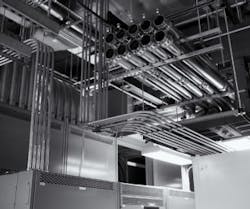As we continue to discuss the take-off, the most material-cost-intensive part is the feeders. Pay special attention to wiring methods. Most of the time, you will be providing copper conductors — either in polyvinyl chloride (PVC), electrical metallic tubing (EMT), or galvanized rigid conduit (GRC), depending on the application.
If the general contractor (GC) requests you to use aluminum wire, you will have to upsize the wire and conduit sizes, because aluminum wire does not carry the same ampacity ratings as copper. Make sure the panel will accept the upsized wire. Although the NEC may state that you can use aluminum wire under certain conditions, the local code or the building’s standard may not. Confer with the AHJ if there is any doubt. Look at the riser. Often, engineers upsize the conduit. If the project is a public bid opening, you should price exactly what you see on the drawings. However, for private jobs, you can size the conduit to Code — but make sure you qualify this in your proposal.
When applying labor to switchgear and panelboards, many estimators spend time “building” a panel, making sure they have all the labor for breaker fill. In my professional opinion, this is a waste of valuable estimating time. As an estimator, determine the average time to install a 200A panelboard, and use that in your estimate.
Make sure that you give your switchgear vendors enough time to quote the switchgear. Review your quote for completeness, and beware of incomplete quotes. For generators, ensure that your quote includes the automatic transfer switches, expensive load banks, and testing.
How will you get your switchgear into the building? For existing buildings, is there room to bring these types of items in? For a new building, will you need rigging or a crane to set them in place? If you are hiring a crane, check with your local jurisdiction about road closures and permits. Will they have to be set on a weekend, incurring extra costs? All of these issues should be factored into your take-off.
If mechanical disconnects are shown on the riser but will be provided on the equipment, make sure that your switchgear quote does not include them. Likewise, if you have to provide them, make sure your quote reflects this too. We generally exclude generator fuel, start-up, and testing in our quotes. If you don’t exclude what you don’t “own,” you might end up owning it anyway.
Another good chunk of your material costs will be the incoming utilities. Know your local codes and what your local electric utility company provides. Often, the electrical contractor owns the incoming conduits, and the electric utility company owns the primary wire and transformer. Read the specs carefully to ensure you are estimating the appropriate site conduit, noting the difference in price between GRC, Schedule 80 or 40 PVC. Do you own trenching and backfilling? That usually depends on the area of the country you’re in. Do you own the transformer pad?
Site lighting usually goes along the same lines as site utilities, so again, pay attention to the type of conduit required. Sometimes, Schedule 80 PVC is used in lieu of Schedule 40 PVC when being run under a parking lot with heavy traffic. Do you own the site poles, or will the concrete contractor provide these? Again, consider the cost of rigging these poles into place, depending on their height. Will you need a crane, or can you use your bucket truck to set the poles? Is there any landscape lighting or special lighting in outdoor handrails or stairs? Sometimes, this lighting is “hidden” on architectural details, which is why I suggested in a previous article that you should review all the drawings.
Finally, let’s discuss low-voltage systems, including tel/data, fire alarm, security, and audio/visual systems. Once more, check your bid package to see exactly what you own. You may be responsible for stub-ups only for tel/data and not the wiring or terminations. On another project, you may own all the tel/data, including raceway, wiring, patch panels, and terminations. Again, check your local codes for fire alarm requirements. Although the NEC can approve of a certain wiring method, your local electrical code may differ. For example, in Rhode Island, all fire alarm wiring must be in conduit unless you get pre-authorization to use fire alarm metal-clad (MC) cable. In the city of Chicago, for example, all residential wiring must be in EMT conduit; no Romex or MC cable is allowed.
Security work is often done by a security subcontractor. You may be providing stub-ups or the raceway system only, so check your bid package. The same goes for audio/visual work. Typically, a specialty contractor handles this, leaving the electrical contractor responsible for the stub-ups or raceway system.
At this point, the take-off is done. Unfortunately, your work as an estimator is just beginning. Next month, we’ll examine tips and techniques for checking your estimate for accuracy, assembling quotes, and determining what direct job expenses will need to be covered to turn your estimate into a proposal.
Candels is president of Candels Consulting, an electrical estimating consulting firm in Niantic, Conn. She can be reached at [email protected].
